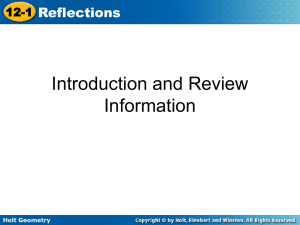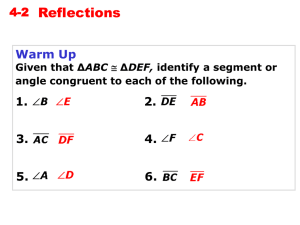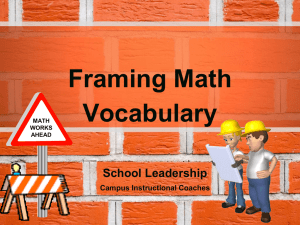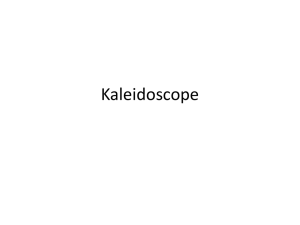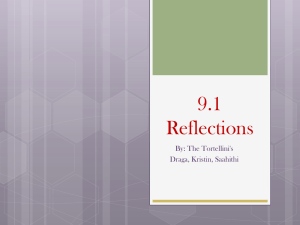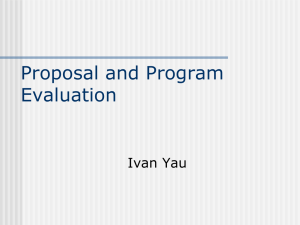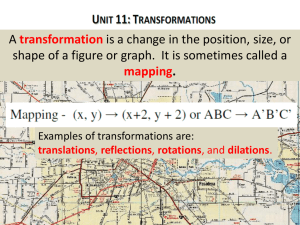File reflectionsx
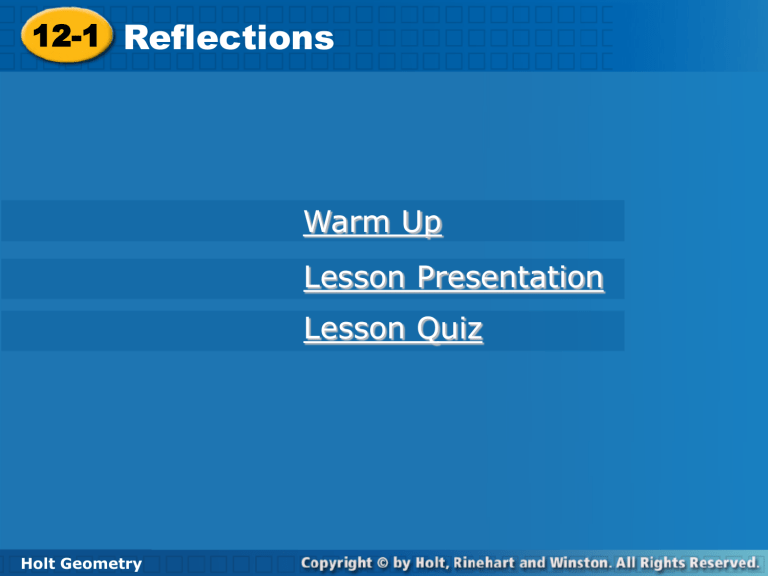
Warm Up
Lesson Presentation
Lesson Quiz
12-1 Reflections
3.
5.
Warm Up
Given that ∆ABC ∆DEF, identify a segment or angle congruent to each of the following.
1.
2.
4.
6.
Holt Geometry
12-1 Reflections
Objective
Identify and draw reflections.
Holt Geometry
12-1 Reflections
Vocabulary
isometry
Holt Geometry
12-1 Reflections
An isometry is a transformation that does not change the shape or size of a figure. Reflections, translations, and rotations are all isometries.
Isometries are also called congruence transformations or rigid motions.
Recall that a reflection is a transformation that moves a figure (the preimage) by flipping it across a line. The reflected figure is called the image. A reflection is an isometry, so the image is always congruent to the preimage.
Holt Geometry
12-1 Reflections
Example 1: Identifying Reflections
Tell whether each transformation appears to be a reflection. Explain.
A.
B.
No; the image does not
Appear to be flipped.
Yes; the image appears to be flipped across a line..
Holt Geometry
12-1 Reflections
Remember!
To review basic transformations, see Lesson 1-7, pages 50–55.
Holt Geometry
12-1 Reflections
Check It Out!
Example 1
Tell whether each transformation appears to be a reflection.
a.
b.
No; the figure does not appear to be flipped.
Yes; the image appears to be flipped across a line.
Holt Geometry
12-1 Reflections
Draw a segment from each vertex of the preimage to the corresponding vertex of the image. Your construction should show that the line of reflection is the perpendicular bisector of every segment connecting a point and its image.
Holt Geometry
12-1 Reflections
Holt Geometry
12-1 Reflections
Example 2: Drawing Reflections
Copy the triangle and the line of reflection.
Draw the reflection of the triangle across the line.
Step 1 Through each vertex draw a line perpendicular to the line of reflection.
Holt Geometry
12-1 Reflections
Example 2 Continued
Step 2 Measure the distance from each vertex to the line of reflection. Locate the image of each vertex on the opposite side of the line of reflection and the same distance from it.
Holt Geometry
12-1 Reflections
Example 2 Continued
Step 3 Connect the images of the vertices.
Holt Geometry
12-1 Reflections
Check It Out!
Example 2
Copy the quadrilateral and the line of reflection.
Draw the reflection of the quadrilateral across the line.
Holt Geometry
12-1 Reflections
Example 3: Problem-Solving Application
Two buildings located at A and B are to be connected to the same point on the water line. Where should they connect so that the least amount of pipe will be used?
1 Understand the Problem
The problem asks you to locate point X on the water line so that AX + XB has the least value possible.
Holt Geometry
12-1 Reflections
Example 3 Continued
2 Make a Plan
Let B’ be the reflection of point B across the water line. For any point X on the water line, so AX + XB = AX + XB’.
AX + XB’ is least when A, X, and B’ are collinear.
Holt Geometry
12-1 Reflections
Example 3 Continued
3 Solve
Reflect B across the water line to locate B’.
Draw and locate X at the intersection of and the water line.
Holt Geometry
12-1 Reflections
Example 3 Continued
4 Look Back
To verify your answer, choose several possible locations for X and measure the total length of pipe for each location.
Holt Geometry
12-1 Reflections
Check It Out!
Example 3
What if…? If A and B were the same distance from the river, what would be true about and ?
A B
River
X and would be congruent.
Holt Geometry
12-1 Reflections
Holt Geometry
12-1 Reflections
Example 4A: Drawing Reflections in the Coordinate
Plane
Reflect the figure with the given vertices across the given line.
X(2, –1), Y(–4, –3), Z(3, 2); x-axis
The reflection of ( x, y ) is ( x,–y ).
X( 2,–1 ) X’( 2, 1 )
Y( –4,–3 ) Y’( –4, 3 )
Z( 3, 2 ) Z’( 3, –2 )
Y’
Y
X’
Z
X
Z’
Graph the image and preimage.
Holt Geometry
12-1 Reflections
Example 4B: Drawing Reflections in the Coordinate
Plane
Reflect the figure with the given vertices across the given line.
R(–2, 2), S(5, 0), T(3, –1); y = x
S’
The reflection of ( x, y ) is ( y, x ).
R( –2, 2 ) R’( 2, –2 )
R
T’
S( 5, 0 ) S’( 0, 5 )
T( 3, –1 ) T’( –1, 3 )
S
T
Graph the image and preimage.
R’
Holt Geometry
12-1 Reflections
Check It Out!
Example 4
Reflect the rectangle with vertices S(3, 4),
T(3, 1), U(–2, 1) and V(–2, 4) across the x-axis.
The reflection of ( x, y ) is ( x,–y ).
S( 3, 4 ) S’( 3, –4 )
T( 3, 1 ) T’( 3, –1 )
V S
U( –2, 1 ) U’( –2, –1 )
V( –2, 4 ) V’( –2, –4 )
U
U’
T
T’
Graph the image and preimage.
V’ S’
Holt Geometry
12-1 Reflections
Lesson Quiz: Part I
1. Tell whether the transformation appears to be a reflection.
yes
2. Copy the figure and the line of reflection. Draw the reflection of the figure across the line.
Holt Geometry
12-1 Reflections
Lesson Quiz: Part II
Reflect the figure with the given vertices across the given line.
3. A(2, 3), B(–1, 5), C(4,–1); y = x
A’(3, 2), B’(5,–1), C’(–1, 4)
4. U(–8, 2), V(–3, –1), W(3, 3); y-axis
U’(8, 2), V’(3, –1), W’(–3, 3)
5. E(–3, –2), F(6, –4), G(–2, 1); x-axis
E’(–3, 2), F’(6, 4), G’(–2, –1)
Holt Geometry
